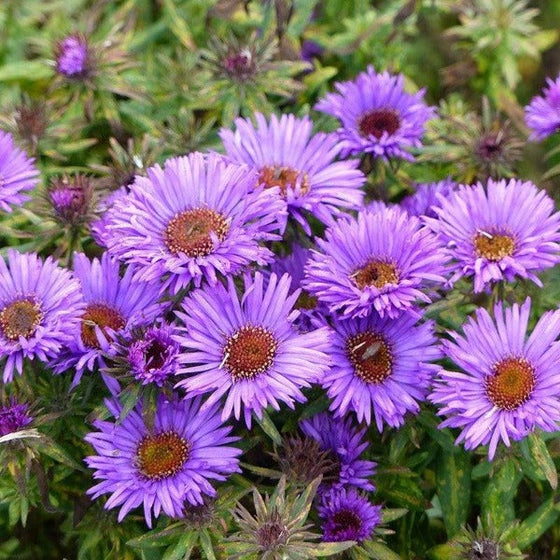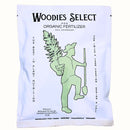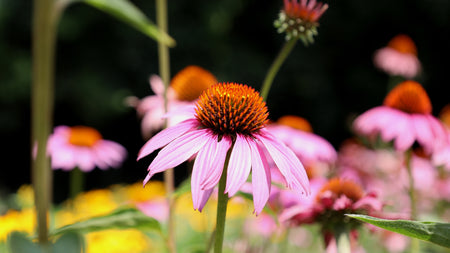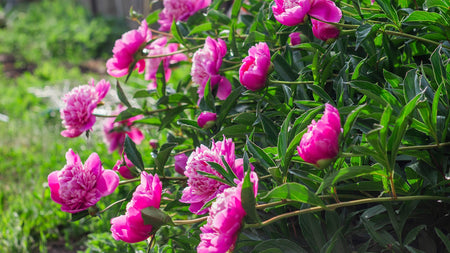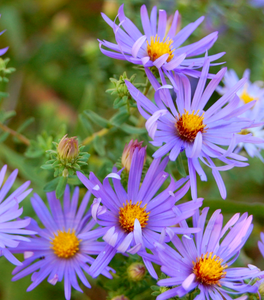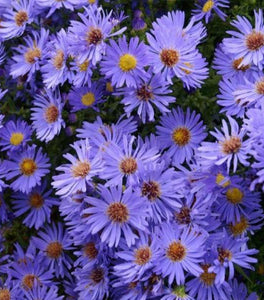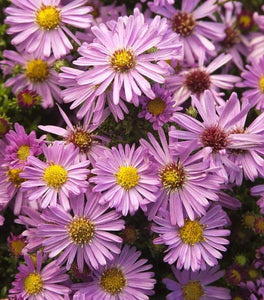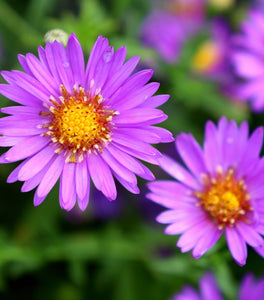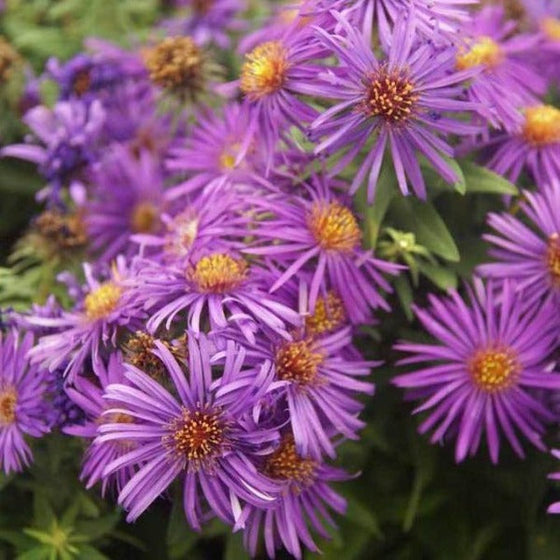
Images Depict Mature Plants
Aster Purple Dome (Symphyotrichum novae-angliae 'Purple Dome')
Aster 'Purple Dome' (Symphyotrichum novae-angliae 'Purple Dome') is a compact, mounding perennial known for its vibrant late-season color and pollinator appeal. This New England aster cultivar produces masses of rich, violet-purple daisy-like flowers with golden centers, blooming from late summer through fall when much of the garden begins to fade. Reaching only 18 to 24 inches tall and wide, Purple Dome Aster is ideal for small garden spaces, borders, and containers, offering bold color and texture without overwhelming nearby plants.
Thriving in full sun and well-drained soil, Aster Purple Dome is a hardy and low-maintenance native plant well-suited for USDA Zones 4–8. Its compact growth habit makes it an excellent choice for the front of perennial beds, rock gardens, or butterfly gardens. Not only is it highly resistant to mildew—a common issue with other asters—but it also attracts bees, butterflies, and other beneficial pollinators, making it a valuable addition to any pollinator-friendly landscape. Once established, it is also moderately drought-tolerant and deer-resistant.
Perfect for extending color into the fall, Purple Dome Aster pairs beautifully with ornamental grasses, goldenrods, sedums, and other autumn perennials. Its dense habit and long bloom period provide both aesthetic and ecological benefits in naturalistic plantings, native gardens, or formal designs. Whether used as a colorful border plant or in mass plantings for dramatic seasonal impact, Aster Purple Dome delivers reliable performance and brilliant beauty when your garden needs it most.
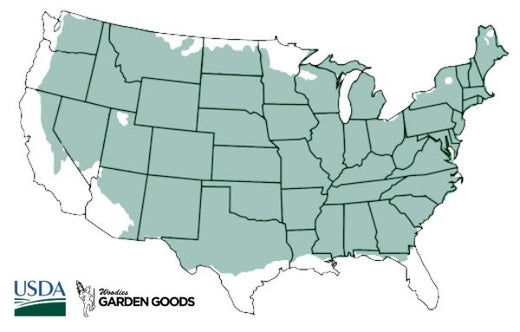
| Hardiness Zone: | 4-8 |
|---|---|
| Mature Height: | 12 to 18 Inches |
| Mature Width: | 1.5 to 2 Feet |
| Classification: | Perennial |
| Sunlight: | Partial to Full Sun |
| Habit: | Upright, clump forming |
| Flower Color: | Purple |
| Flowering Season: | Late Summer to Fall |
| Foliage: | Dark Green |
| Soil Condition: | Prefers dry, average to slightly moist soil, wont tolerate wet soil in winter |
| Water Requirements: | Water well until established. |
| Uses: | Extremely attractive when used as a focal point in the mixed border, mass planting. Attracts pollinators. |
How to Care for Aster Purple Dome
Be sure to read our planting instructions to ensure a healthy and happy Aster Purple Dome plant for years to come!
How Do I Plant My Aster Purple Dome Plants?
To plant your Aster Purple Dome plants, start by selecting a site that receives full sun, as this ensures the densest growth and most abundant flowering. These compact perennials thrive in well-drained soil and can tolerate a range of soil types, from sandy to loamy, though they prefer moderately fertile conditions. Begin by loosening the soil and amending with compost if needed to enhance drainage and organic matter. Dig a hole twice as wide and just as deep as the plant’s root ball, then place the aster so the top of the root ball is level with the soil surface. Backfill with soil, press gently to remove air pockets, and water thoroughly to settle the roots. Space your Purple Dome Asters about 18 to 24 inches apart to allow good air circulation, which helps prevent disease and keeps the plants looking neat and full. Apply a 2- to 3-inch layer of mulch around the base to retain soil moisture and suppress weeds, but avoid piling mulch against the stems. These asters are perfect for front-of-border plantings, pollinator gardens, and fall color displays, and they integrate beautifully with native grasses and other late-blooming perennials. With proper planting and care, Aster Purple Dome will establish quickly and bring brilliant purple blooms and beneficial pollinators to your landscape year after year.
How Do I water My Aster Purple Dome Plants?
Watering your Aster Purple Dome plants correctly is key to establishing strong roots and promoting healthy growth and vibrant blooms. During the first growing season, water deeply once or twice per week, allowing the top few inches of soil to dry slightly between waterings. This encourages deep root development and helps the plant become more resilient to heat and short dry spells. Use a soaker hose or water at the base of the plant to avoid wetting the foliage, which can help prevent mildew—especially important for asters. Once established, Purple Dome Asters are relatively drought-tolerant, but they’ll perform best with consistent moisture during the active growing and blooming periods. During hot, dry weather or when planted in sandy soils, check soil moisture regularly and water when the top 2–3 inches feel dry. Mulching around the base of the plant helps conserve soil moisture and minimize fluctuations in soil temperature. With thoughtful watering practices, your Aster Purple Dome plants will reward you with dense mounds of rich purple blooms and attract a wide range of pollinators to your garden.
How Do I Fertilize My Aster Purple Dome Plants?
To fertilize your Aster Purple Dome plants, begin with a light application of a balanced, slow-release fertilizer in early spring as new growth emerges. A formula like 10-10-10 or an organic option such as compost or well-rotted manure will provide essential nutrients to support lush foliage and vigorous blooming later in the season. Spread the fertilizer evenly around the base of the plant, keeping it a few inches away from the stems, and water thoroughly to help nutrients absorb into the soil. Avoid over-fertilizing, as excessive nutrients—especially nitrogen—can lead to leggy growth and fewer blooms. For best results, Purple Dome Asters should be fertilized only once per growing season, as they are naturally hardy and thrive in moderately fertile soils. If your soil is poor or your plants show signs of slow growth or pale leaves, a second light feeding in mid-summer with a bloom-boosting fertilizer (low nitrogen, higher phosphorus) can encourage more prolific flowering. Be sure to pair fertilization with proper watering and full sun exposure to maximize flower production. With the right fertilizing routine, your Aster Purple Dome plants will produce dense mounds of vibrant purple flowers that brighten the garden from late summer into fall.

How and When Do I prune My Aster Purple Dome Plants?
Pruning your Aster Purple Dome plants is important for maintaining a compact, tidy shape and encouraging more vigorous blooming. In early summer, you can perform a light pruning or pinching back by removing the top few inches of growth. This helps promote branching and results in a fuller plant with more flower buds by the time fall arrives. Pruning at this stage also helps prevent the plant from becoming leggy and reduces the risk of it flopping over when in bloom. Always use clean, sharp shears to avoid damaging the stems. After the blooming season ends in late fall, you can cut back Purple Dome Asters to a few inches above the ground once the foliage begins to die back. This end-of-season pruning helps prevent overwintering pests and diseases and gives your garden a clean appearance through winter. In cold climates, some gardeners prefer to leave the stems until early spring to provide winter interest or shelter for beneficial insects, then prune just before new growth emerges. With proper and timely pruning, your Aster Purple Dome plants will stay healthy, compact, and bursting with vibrant purple blooms year after year.

